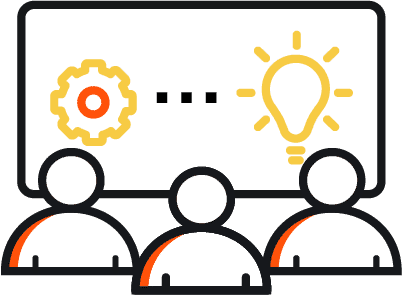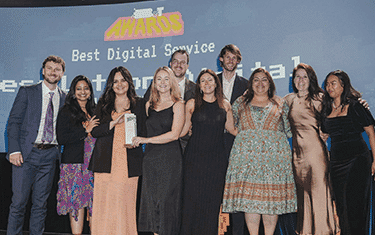The demand to deliver new, alternative solutions to the challenges of today, drive growth and create value for customers is putting greater emphasis on innovation and creative problem solving.
To do this, design thinking has come to the fore as a powerful way to approach problem solving and develop innovative solutions that put the interests of the customer at the center of the solution.
The benefits of design thinking are numerous — it offers a structured process to understand problems and challenges, generate ideas, experiment and test solutions and then iterate through review and feedback to improve the outcome.
Overview:
What is Design Thinking?
Design thinking is a practical step-by-step methodology that defines a process for human-focused solutions with an emphasis on developing new ideas and innovative approaches to problems. It takes a human-centered approach that encourages empathy, collaboration and experimentation to create solutions that meet the needs of customers or users.
Design thinking has been defined by IDEO as a problem-solving approach that puts the user at the center of the solution.
"Design thinking is a human-centered approach to innovation that draws from the designer's toolkit to integrate the needs of people, the possibilities of technology, and the requirements for business success."– Tim Brown, Executive Chair of IDEO.
It’s generally agreed the term was coined by Tim Brown in the 1990s when the international consulting firm IDEO was founded, although the notion of design thinking is thought to go back to the 1940s when studies began to focus on the psychological element in the development and methods of creativity.
Stages of Design Thinking
Design thinking is characterised by a step-by-step approach that lends itself to being circular rather than linear, starting with empathy and then moving on to define, ideate, prototype and finally test. Being structured as a loop, it’s possible to return to an earlier stage if there’s a need to redo that step because challenges or gaps have emerged that need to be addressed.
In the design thinking process, there are five stages, with the final or sixth stage being the implementation stage where the idea comes into being.
Stage 1: Empathise
This first stage is user-centric research and is crucial because it sets the scene for everything that follows. The object is to empathise with the customer or end-user to see the world through their eyes. This means setting aside biases and other things to see them as individuals and learn about their needs, motivations, frustrations and so on. The goal is to understand them and their perspective.
Stage 2: Define
At this stage, the observations and learnings are drawn together with any contextual research such as relevant studies, data and reports to define the core problem/s as a problem statement expressed in a human-centered manner.
By keeping the focus on the person’s needs, it helps direct the problem solving and ideation towards changes or features, functions, tools and services with the person in mind. It is about making improvements or new elements to support the person rather than meeting targets or metrics. Personas can be utilised at this stage to help reinforce to develop an archetype that represents the needs of the target audience.
Stage 3: Ideate
The ideation phase is about generating innovative ideas to suit the problems of the identified customers or end-users. In this phase, it’s important to remove judgments and limiting beliefs by not focussing on technical restrictions, feasibility or budgets.
Creative, out-of-the box thinking can be spurred on by applying different brainstorming techniques such as mind mapping to capture ideas, SWOT analysis to identify strengths, weaknesses, external opportunities and threats, and visualising ideas with sketches or flow charts.
Stage 4: Prototype
In this phase, it’s time for experimentation and transforming some of the best, most suitable ideas into prototypes. Design solutions need to be evaluated through three criteria: desirable, feasible and viable.
It’s an opportunity to develop simple representations and assess the suitability and feasibility of the concepts. This may be simple wireframes, outlines or mock-up of digital products, paper or other low-fidelity prototypes that are rough, minimal examples to investigate how it might work with users.
Stage 5: Test & Iterate
In the test and iterate phase, there are several important processes that need to happen to appraise and improve on the prototypes that have shown potential. This usually entails taking the mock-ups and developing them into high-fidelity examples that customers or end-users can interact with so design teams observe, learn and feedback these insights to improve the original concepts.
It’s a chance to uncover any unforeseen problems and discover opportunities to improve on the design through usability testing, review and discussion. This process shows what is and isn’t working and is a chance to critically evaluate the design concepts.
Final Stage: Implementation
The final stage is implementing the changes and putting the new tools, features or products into the customers or end-users hands.
It’s important to remember that, while each step is clearly articulated, it’s not a linear process and the steps are not always sequential. There may be times when it’s necessary to go back a step or two, such as when brainstorming, testing or prototyping reveals something unexpected that changes the decisions or outcomes in later stages and so the earlier stage needs to update or altered.
Benefits of Design Thinking
Using design thinking for business growth helps improve innovative problem solving leading to better customer satisfaction and growth.
As a user-centred process that starts with user problems and needs, it helps teams focus on the real needs of people to develop and test things with the end-users or customers. It’s a structured process for targeted problem solving that can yield new, unforeseen and innovative approaches to meeting the needs of people.
It helps businesses to focus on the needs of their customers by identifying important customer personas, understand their relationship and experiences with its products and services and rallying teams around the end-goal of improving customer satisfaction through innovative, creating problem solving. This, in turn, leads to stronger customer loyalty, strengthens customer lifetime value and helps drive growth to improve the bottom line.
Design Thinking and Marketing
Design thinking has many applications in business, and particularly in marketing. Focussing on key customer personas and then developing a deep understanding of them is a vital process for customer centricity. Starting from a place of empathy will help in understanding the customer's perspective and creating messaging that resonates with them.
Design thinking as a concept and practice has been embraced by many brands as well as universities, consultancies, research institutes and digital and creative studios as a guiding principle and method for problem solving and creative endeavours.
“Design thinking is a systemic, intuitive, customer-focused problem-solving approach that organizations can use to respond to rapidly changing environments and to create maximum impact.” - McKinsey
It helps in closing the gap between the customer’s pain points, needs, goals and challenges and the business’s products and services offerings and will support customer loyalty and business growth. Design thinking is essential to deliver excellent customer experience and fostering loyalty through long-term relationships.
Implementing Design Thinking
Embracing design thinking requires the organisation to have the space and know-how to carry out problem solving and idea generation using the five-stage process. Providing the necessary training and resources will give teams a solid grounding in the process of design thinking.
To make the most of this process, organisations need to see the value of this iterative process and foster a culture that embraces design thinking. Encouraging collaboration, testing and learning as well as experimentation will help give team members permission to approach problems in a collaborative way with empathy and an open mind.
Tools
There are a variety of different tools and resources that can be used in the process of design thinking. These include:
- User insights, focus groups and interviews.
- Contextual research and reports.
- Brainstorming tools such as mind mapping, SWOT analysis and visualisations.
- Mock-up, design and prototyping software.
Case Study Examples
There are many examples of well-known brands utilising design thinking to develop innovative new products and services, for brand redesign and to solve customer challenges.
AirBnB used design thinking to get in the heads of customers and fully understand their needs when booking accommodation.
Apple has long applied this creative, intuitive approach by designing its products with the user at the heart rather than the technology.
Pepsi has embraced design thinking to understand what products appeal to customers.
Netflix used design thinking to turn home video on its head with mail-back DVD rental and streaming.
Conclusion
Design thinking is an innovative approach to deepening customer engagement because it focuses on the unique and specific needs of end-users and customers and addresses these with creative, targeted ideas.
The design thinking benefits for business is offering an innovative approach to deepening customer engagement by focussing on their unique, specific needs and addressing these with creative, targeted ideas.
At a time when customer expectations are rapidly changing and the businesses environment is highly changeable, design thinking is a powerful way to remain competitive through being customer focussed.
Prevent Creative Fatigue on your Digital Assets
Creative fatigue occurs when the same creative is shown to the same audience to the point where it is no longer effective. We have developed a proprietary technology that can monitor and alert marketers to when a creative starts to fatigue so that it can be swapped out or optimised.
.jpg?w=375&cw=375&ch=450)









.png?)
.png?)


.jpg?cw=376&ch=240&crop.type=poi)

